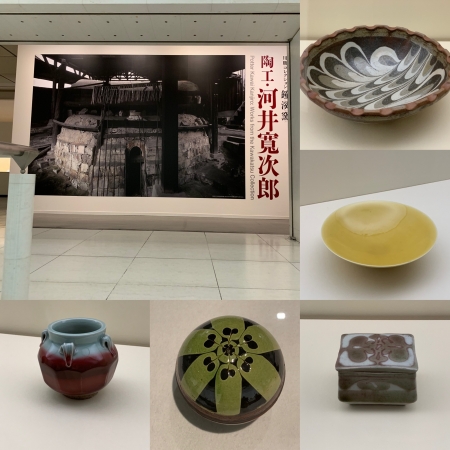くすむ
京都近代美術館で開催されている「陶工・河井寛次郎」展を見た。河井寛次郎というと、民藝の人というイメージしかなく、特に詳しい訳ではないが、知り合いの投稿を見て、行ってみようと決めた。
河井寛次郎の作品を今までに何度か目にしたことがあり、典型的な民藝の作家と思っていたが、今回は初期から晩年までの作品を時系列で見ることができ、そうすると、印象がだいぶ違うものになった。
形にかなりのバリエーションがあり、それは決して民藝のような保守的というか、日常の生活に根差したものでは無いように思えた。
河井の大正時代の初期の作品が素晴らしく、民藝に関わる前の朝鮮やその他の陶器を手本にしたらしいが、すでに完成度が非常に高く、技巧とセンスの繊細さが天才的とすら思えた。きっと、このような仕事は河井にとっては難なくできることであり、だから、その後、民藝運動を提唱する最初のメンバーになり、自分の仕事に芯となるものが欲しかったのではないだろうか。
ただ、初期から晩年までの作品を通しで見てみると、明らかに、民藝運動に関わり出してから、作品に変化が出る。
民藝運動に関わる前は、繊細で聡明で、釉薬の色も鮮やかだったのに対して、民藝運動に関わるようになると、繊細さは消え、色使いがくすむようになって来た。それはそれで、もちろん良いのだが、初期の、民藝運動に関わる前の作品がとても素晴らしいだけに、民藝運動に関わることによって、その初期の作品が持っていた良さが消えてしまい、全体的にくすんでしまったような印象だ。
河井寛次郎がもし民藝運動に関わらなかったら、初期の作品からどのように展開されただろうか、と想像してみると、ちょっとだけ惜しいような気がした。
"Kusumu"
I saw the "Poster, Kawai Hirojiro" exhibition held at the Museum of Modern Art, Kyoto. Kawai Kanjiro has only an image of a folk song. It is not particularly detailed, but I decided to go and see the posts of acquaintances.
I have seen Kawai Kanjiro's works several times before and thought that I was a typical folk artist, but this time I can see works from early to late years in chronological order, and then, The impression was quite different.
There was considerable variation in shape, and it did not seem to be as conservative as a folk song or rooted in everyday life.
Kawai's early works in the Taisho era are wonderful, and they seem to have modeled on the former Korean and other pottery involved in folk songs, but their degree of completion is already very high, and the subtleties of skill and sense seem even genius . Surely such work is something that can be done without difficulty for Kawai, so it might be that I wanted to become the first member to advocate the folk song movement and to be the core of my work.
However, when you look through the works from the early to the late years, obviously, the works will change after they get involved in the folk song movement.
Before being involved in the folk song movement, it was delicate and bright, and while the color of the glaze was bright, when it came to be involved in the folk movement, the delicacy disappeared and the use of colors began to get worse. So it is of course good, but because the early works of the folk song movement were so wonderful, the goodness of the early work disappeared by being involved with the folk movement, and overall It looks like it has become dull.
I imagined that it was a bit lonely when I imagined that Kawai Kanjiro had not been involved in the folk song movement, and how it would be developed from the early works.

